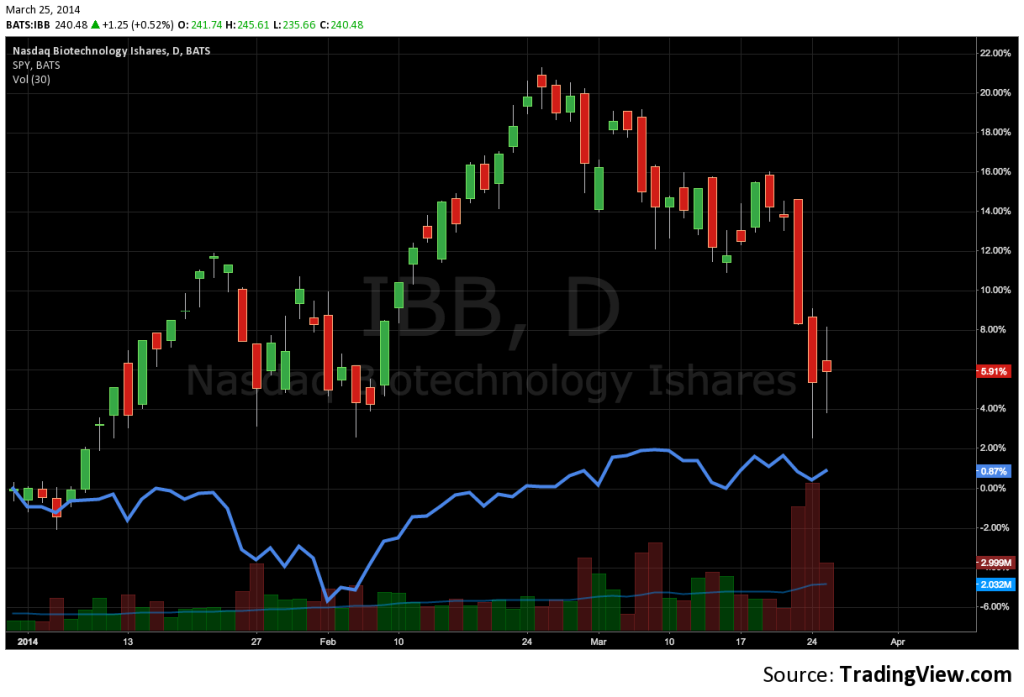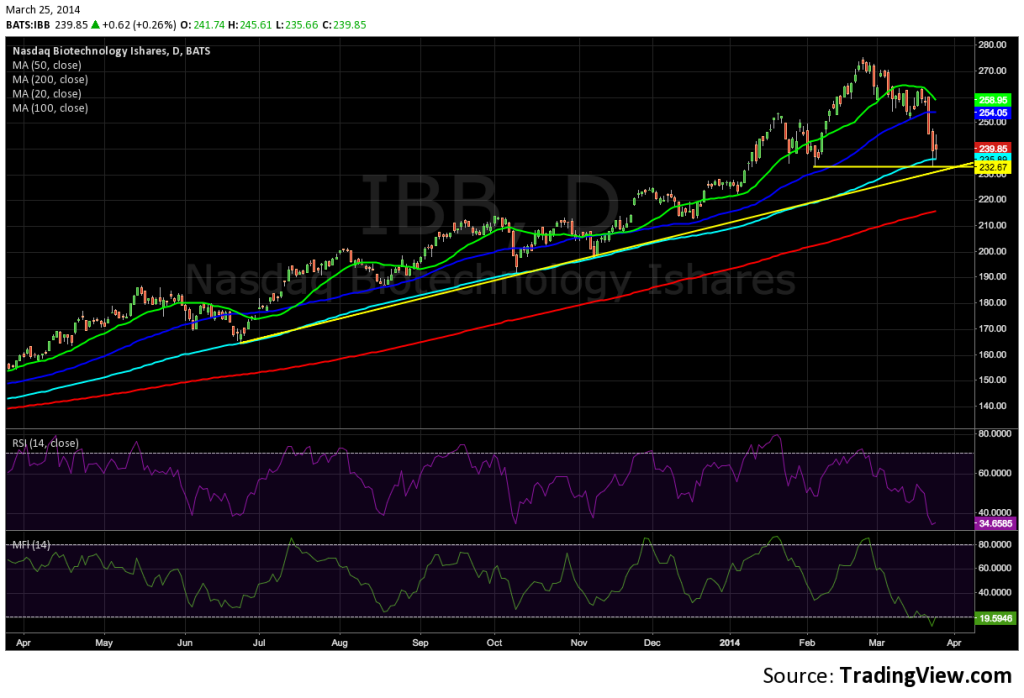Bubble. Top. Sell. We’ve been hearing biotech “bubble” talk for months as the iShares Nasdaq Biotechnology Index (IBB) has rallied 250% from 2008 lows (120% for the S&P 500). Underlying the rally to an extent is generalist participation in the sector that stands at all-time highs – or did until last week. Generalist investors such as mutual funds largely steered clear of biotech following the genomics disaster over a decade ago, but chasing the sectors’ astronomical returns (read: avoiding underperformance) brought generalists back around in 2013.
IBB is now off 13% from its February highs, up 6% YTD (the S&P is flat over both timeframes), and sold off on heavy volume in the last two days with tepid headlines acting as the primary catalyst.
A number of respected individuals have weighed in this week with insightful commentary on the current phenomenon. Sector-outsider Josh Brown (AKA The Reformed Broker) offered on Monday a slew of reasons why investors should proceed with caution. Alternatively, ISI Analyst Mark Schoenebaum went on CNBC on Tuesday to talk Gilead (GILD), suggesting that he would be surprised if there were more than 5% of downside left in the current correction – his airtime on CNBC seemed to put a temporary halt to the day’s sell-off.
We won’t pretend to have foresights that predict future market movements with certainty. Directionality will ultimately be a function of the herd’s reaction to permeating news flow. Given the fickle, short-term nature of investor sentiment when unlinked from fundamentals, we place minimal confidence in anyone’s ability to predict how share prices will react to yet unknown events.
So, what should you, as a biotech investor, be looking at? Is this the end of the line or not?
Technical analysis provides a relevant backdrop against which to assess these questions, keeping an eye on key support levels for near-term directionality of sector-tracking funds. A combination of the 100-day SMA and February lows has provided support at 235 for the ETF thus far. With figures like Schoenebaum publicly “defending” the sector (see link above), investor sentiment could revert to historical, longer-term trends and track the 100-day SMA higher. We would not be surprised to see such an outcome in the short-term.
Breaking support at 235 likely results in a repeat of the trajectory seen over the past few days. We view support next buoying IBB at 213, roughly the 200-day SMA (see chart below for details).
To consider next month, and giving us greater pause, would be an understood reversal pattern forming over the next 2-4 weeks. Two tells, in this case: the IBB not quite returning to its all-time highs before giving back gains and approaching current prices for a retest of this support level – a clear head-and-shoulders pattern that would result in the benchmark trading sideways, or worse, bearish. Likewise, a double-top (highs and retest/break of current support) would be particularly bearish for the ETF and sector as a whole.
Technicals only inform us of trading decisions. It’s prudent for fundamental investors in this environment to know what you own, why you own it, and have cash ready to deploy for compelling opportunities. Further, it’s securities with clear and defined catalysts that have the greatest probability of success in a tentative market environment – catch up on why we like Synergy Pharmaceuticals (SGYP), for example. While valuations for mid- to large-cap biotechnology companies like Gilead and Celgene (CELG) may still be justifiable, as argued by a number of sell-side analysts this week, valuations can still take a back seat if bearish sentiment becomes the norm. Perhaps most important, keep in mind that the plethora of high-flying small-cap bios with nominal clinical data and early-stage pipelines will be the hardest hit on a weakening sector outlook.
In connection with GILD, SGYP, and CELG, PropThink has taken a long position.






